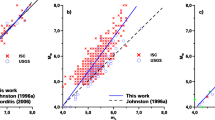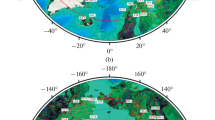Abstract
The aim of the present work is to compile and update a catalogue of the instrumentally recorded earthquakes in Egypt, with uniform and homogeneous source parameters as required for the analysis of seismicity and seismic hazard assessment. This in turn requires a detailed analysis and comparison of the properties of different available sources, including the distribution of events with time, the magnitude completeness, and the scaling relations between different kinds of magnitude reported by different agencies. The observational data cover the time interval 1900–2004 and an area between 22°–33.5° N and 25°–36° E. The linear regressions between various magnitude types have been evaluated for different magnitude ranges. Using the best linear relationship determined for each available pair of magnitudes, as well as those identified between the magnitudes and the seismic moment, we convert the different magnitude types into moment magnitudes M W, through a multi-step conversion process. Analysis of the catalogue completeness, based on the M W thus estimated, allows us to identify two different time intervals with homogeneous properties. The first one (1900–1984) appears to be complete for M W ≥ 4.5, while the second one (1985–2004) can be considered complete for magnitudes M W ≥ 3.
















Similar content being viewed by others
References
Abdel-Fatah AK (1996) Rupture process characteristics of August 1993 Aqaba earthquake sequence. Ph.D. Thesis, Faculty of Science, Ain Shams University, Egypt
Abdelrahman EM, Dessoky MM, Hussein HH, Abd-El Wahed MF (2003) Estimation of seismic moments from local magnitudes and coda durations for Cairo earthquake aftershocks recorded at Kottamiya (KEG) broadband station. Ann Geophys 46(6):39–46
Abd-El Wahed MF (1998) Seismological study on Dahshour earthquake source using digital data analysis techniques. M.Sc. Thesis, Faculty of Science, Cairo University, Egypt
Abou Elenean KM (1997) A study on the seismotectonic of Egypt in relation to the Mediterranean and Red Seas tectonics. Ph.D. Thesis, Faculty of Science, Ain Shams University, Cairo, Egypt, 200 pp
Abou Elenean KM, Hussein HM (2007) Source mechanism and source parameters of May 28, 1998 earthquake, Egypt. J Seismol 11:259–274
Aswan Seismological Network Bulletin, Aswan Seismological Center (1981–1997) National Research Institute of Astronomy and Geophysics, Helwan, Cairo, Egypt
Ben-Zion Y, Zhu L (2002) Potency-magnitude scaling relations for southern California earthquakes with 1.0 < ML < 7.0. J Geophys Int 148:F1–F5
Christova CV, Nikolova S (1994) Stress field in the Hellenic Wadati-Beniff zone; ESC, XXIV General Assembly 1994, Sept. 19–24, Athens, Greece. Proceeding and activity report, pp 387–393
Egyptian Geological Survey and Mining Authority, EGSMA (1981) Geologic map of Egypt 1:2000000
Gergawi A, El Khashab HM (1968) Seismicity of the UAR. Bull Helwan Observ 76:1–27
Gutenberg B, Richter CF (1944) Frequency of earthquakes in California. Bull Seismol Soc Am 34:185–188
Hanks TC, Boore DM (1984) Moment–magnitude relations in theory and practice. J Geophys Res 89:6229–6235
Hofstetter A (2003) Seismic observations of the 22/11/1995 Gulf of Aqaba earthquake sequence. Tectonophysics 369:21–36
Ismail A (1960) Near and local earthquakes of Helwan (1903–1950). Bull Helwan Observ 49:33
Kanamori H (1977) Energy release in great earthquakes. J Geophys Res 82:2981–2987
Kanamori H, Anderson DL (1975) Theoretical basis of some empirical relations in seismology. Bull Seismol Soc Am 65:1073–1095
Kebeasy RM (1990) Seismicity of Egypt. In: Said R (ed) The geology of Egypt. A.A. Balkema, Rotterdam, pp 51–59
Kebeasy, RM, Ibrahim EM, Dessoky MM, Bayomi AE (1996) The final report of the project “Determination of the active seismic sources in Arab Republic of Egypt”. Department of Seismology, National Research Institute of Astronomy and Geophysics (NRIAG), Egypt
Lee WH, Bennett RF, Meagher KL (1972) A method of estimating magnitude of local earthquakes from signal duration. U.S. Geological Survey, open-file rep. 28 pp
Maamoun M (1978) Helwan seismic magnitude scale. Academy of Scientific Research and Technology, Helwan Institute of Astronomy and Geophysics, Bulletin No. 169
Maamoun M, Megahed A, Allam A (1984) Seismicity of Egypt. Bull Helwan Inst Astro Geophys IV, Ser B:109–160
Marzouk IA, Megahed AS, Ibrahim EM, Mousa HH, Ahmed AS, Mohamed HF, Abdel Fatah R, El Sayed A, Himida M, Inour H, Hurukawa N, Murakami H, Sugiyama S (1996) Seismological Bulletin of Hurghada Seismograph Network (HSN) No. 1, 2 NRIAG, Department of Seismology, Egypt
Peresan A, Rotwain IM (1998) Analysis and definition of magnitude selection criteria for NEIC (PDE) data, oriented to the compilation of a homogeneous updated catalogue for CN monitoring in Italy. The Abdus Salam International Centre for Theoretical Physics. ICTP, Miramare, Trieste, Italy. Internel Preprint IC/98/97
Primakov I, Rotwain I (2003) The package for analysis of earthquake catalogues (EDCAT, CATAL and AFT). Seventh workshop on non-linear dynamics and earthquakes prediction, ICTP, Trieste, Italy
Riad S, Meyers H (1985) Earthquake catalog for the Middle East Countries 1900–1983. World Data Center for Solid Earth Geophysics, Rep. SE-40. National Oceanic and Atmospheric Administration (NOAA), US Department of Commerce, Boulder, Colorado, USA
Romanelli F, Panza GF (1995) Effect of source depth correction on the estimation of earthquake size. Geophys Res Lett 22(9):1017–1019
Salamon A, Hofstetter A, Garfunkel Z, Ron H (1996) Seismicity of the Eastern Mediterranean Region: perspective from the Sinai subplate. Tectonophysics 263:293–305
Shapira A (1988) Magnitude scales for regional earthquakes monitored in Israel. Isr J Earth Sci 37:17–22
Sieberg A (1932) Erdbebengeographie, in Guttenberg, Handbuch der Geophysik, Band IV, Abschnitt VI. Berlin
Sofratome Group (1984) El-Dabaa nuclear power plant. NPPA, Ministry of Electricity, Egypt, Unpublished report
Acknowledgement
We thank Mrs. Dilys Girilli, ICTP, Italy for reviewing the manuscript.
Author information
Authors and Affiliations
Corresponding author
Rights and permissions
About this article
Cite this article
Hussein, H.M., Abou Elenean, K.M., Marzouk, I.A. et al. Integration and magnitude homogenization of the Egyptian earthquake catalogue. Nat Hazards 47, 525–546 (2008). https://doi.org/10.1007/s11069-008-9237-3
Received:
Accepted:
Published:
Issue Date:
DOI: https://doi.org/10.1007/s11069-008-9237-3




